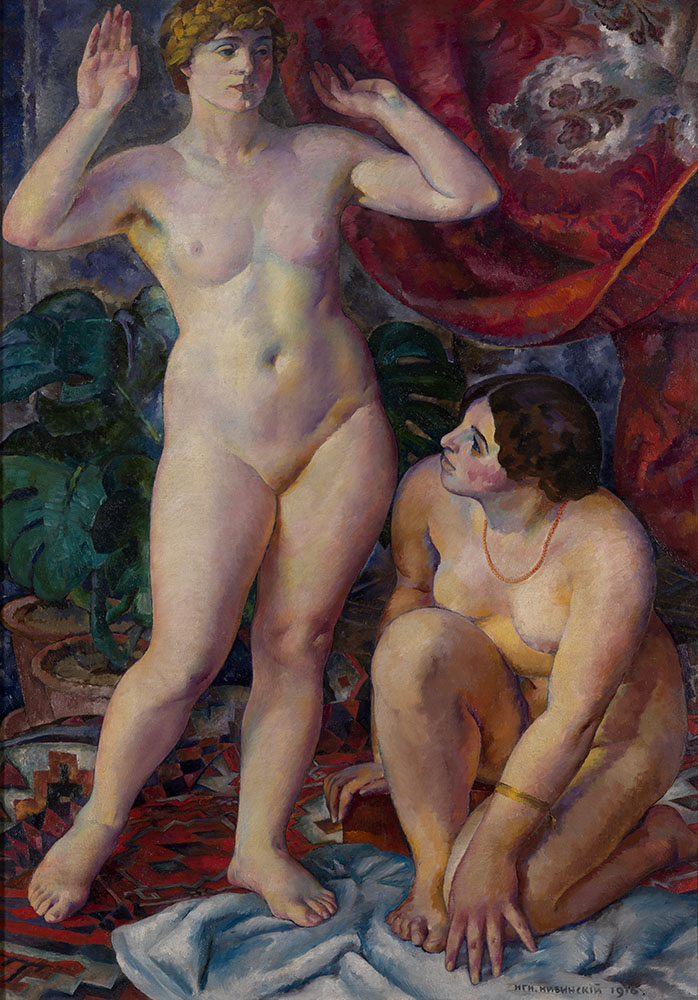MacDougall's Russian Art Auctions 27-30 May 2012
27 May 2012

* 14. NIVINSKY, IGNATY (1880-1933)
Two Female Figures (Venus), signed and dated 1916.
Oil on canvas, 159 by 112 cm.
260,000–400,000 GBP
Provenance: Private collection, Europe.
Authenticity of the work has been confirmed by the experts E. Ivanova and A. Kiseleva.
Exhibited: Ignaty Ignat’evich Nivinsky, 1880–1933. Vystavka k stoletiyu so dnya rozhdeniya, Pushkin State Museum of Fine Arts, Moscow, 1980, No. 357.
Literature: V. Dokuchaeva, Ignaty Nivinsky, Moscow, Sovetskii khudozhnik, 1969, p. 42, No. 14, illustrated, titled Venera.
Exhibition catalogue, Ignaty Ignat’evich Nivinsky, 1880–1933. Vystavka k stoletiyu so dnya rozhdeniya, Moscow, 1980, p. 74, No. 357, listed.
Nivinsky’s reputation as a painter came from the nudes that he painted in the spirit of Neoclassicism in 1916. In these works the “confirmed Italianist”, as the artist called himself, tried to engage with the methods of the great painters of the Renaissance. It is no coincidence that Nivinsky even chose titles for his paintings in keeping with traditional examples of Italian art. Thus the present lot, entitled Two Female Figures, was long known as Venus, and other similar studio compositions were called Adam and Eve, The Upbringing of Diana and finally the darling of Italian art, Saint Sebastian.
It is not only the names of the pictures; it is first and foremost the look of the models he selected, which brings to mind the
Venetian masters who inspired him. Nivinsky’s aim in his pictures was to create something equivalent to the Renaissance ideal of beauty. Somehow he sets a full-blooded sense of life, health and harmony against the elegance and refinement extolled as the aesthetic ideal by Art Nouveau and Symbolism, and against Cubism’s distortion of form. The renowned art critic Yakov Tugendhold wrote: “Nivinsky has this remarkable urge to rehabilitate the Renaissance beauty of the human body in modern Cubist art with its emphasis on the tangible and material”.
The artist’s chief source of inspiration was Italian monumental and decorative painting. Having made several trips to Italy in
the early 1900s with Zholtovsky, the renowned Neoclassical architect, Nivinsky was enthralled by the magnificent legacy of the Renaissance artists. He produced many sketches and pictorial copies of paintings in the cathedrals and palazzi of Rome, Assisi, Mantua, Pisa and Ferrara.
In painting, Nivinsky was striving for what Zholtovsky was then trying to do in architecture – to revive the classical tradition. Nivinsky carries many of the conventions and methods of decorative and monumental painting over to his smaller easel
compositions: vigorous, intensely vibrant colour covering large flat surfaces, a treatment of form in which the evocative silhouette acquires special importance (the artist sometimes emphasises it by outlining the figure) and a precision in rendering rhythm. Nivinsky combines different principles in his work – monumentalism and easel painting, tradition and modernity. For this reason, his canvasses always evoke pictorial associations.
Two Female Figures with its painterly quality, richness and opulence of tone, and sensual beauty of the female body is reminiscent of the art of the Venetians. His treatment of the image shows the artist operating in his characteristic borderline space. Nivinsky depicts his nude subject neither in an interior setting, though the drapery to the right continues this tradition, nor in a natural setting, though beyond the figures to the left a landscape is clearly visible. His composition is built on contrasting the gentle elastic movement of the crouching figure with the figure thrusting out its arms, yet equilibrium and stability are
preserved. The extraordinary tonal richness and painterly artistry with which Nivinsky communicates the sprightly fragility of the human body put Two Female Figures (Venus) among the most successful examples of the artist’s mythological easel work.
Notes on symbols:
* Indicates 5% Import Duty Charge applies.
Ω Indicates 20% Import Duty Charge applies.
§ Indicates Artist's Resale Right applies.
† Indicates Standard VAT scheme applies, and the rate of 20% VAT will be charged on both hammer price and premium.